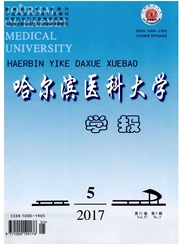

 中文摘要:
中文摘要:
目的采用信息学方法对颈部淋巴瘤和良性反应增生性疾病超声所观察的指标进行识别,评价两者在诊断中的差别,进而提高临床诊断率。方法选择82例颈部淋巴结肿大患者,其中淋巴瘤29例,良性反应增生性疾病53例。在考虑超声指标问关系的同时通过统计分析与信息学方法(均值t检验法,频率分布法,层次聚类法,R×C列联表检验,决策森林)进行特征选择并采用4个分类器进行评价,达到对颈部淋巴瘤与淋巴结反应增生性疾病做出区分。结果5个定量指标(包膜厚度,L,T,L/T,皮质厚度)与8个定性指标(血流分布类型,淋巴结血供情况,比邻关系,淋巴门类型,皮质与淋巴门界限,皮质类型,皮质增厚情况,皮质回声)分别与淋巴瘤比较大多存在显著性差异(P〈0.001),采用4个分类器对所选特征进行评价,分类效果大多在80%以上。结论通过对选取主要参数进行信息学方法分析得出特征指标的联合效应,对两者的鉴别诊断有重要的临床价值,可提高临床诊断率。
 英文摘要:
英文摘要:
Objective To identify ultrasonic diagnostic characteristics of cervical lymphoma and benign hyperplastic diseases by inforrnatics methods and evaluate the differences of them in diagnosis in order to improve the clinical diagnostic rate. Methods Eighty-two patients with cervical lymph node enlargement were selected, which included 29 cases of lymphoma and 53 cases of benign proliferative. All the cases had a definitive diagnosis by the biopsy, bone marrow biopsy and corresponding inspection. Considering of the relationship of ultrasonic indicators, statistical analysis and the bioinformatics methods (t-test, frequency distribution model, hierarchical clustering, R x C contingency table test, decision forest) were performed for feature selection. Classifiers were used to distinguish the cervical lymphoma from lymph node hyperplasia. Results Five quantitative indicators (lymph node length (L), lateral lymph node size (T), L/T, cortical thickness, coating thickness) and eight qualitative indicators (cortex echo, cortex type, hilus type, the type of lymph node flow, relation between cortex and hilus,cortical thickening, neighbourhood, blood-supply of lymph node) associated with lymphoma were significant with P 〈 0. 001, and the results of classifiers were mostly more than 80%. Conclusion Combined effects of indicators by selecting the main features have important clinical value in differential diagnosis and improving the clinical diagnosis rate.
 同期刊论文项目
同期刊论文项目
 同项目期刊论文
同项目期刊论文
 A novel reannotation strategy for dissecting DNA methylation patterns of human long intergenic non-c
A novel reannotation strategy for dissecting DNA methylation patterns of human long intergenic non-c Identification of cancer-related lncRNAs through integrating genome, regulome and transcriptome feat
Identification of cancer-related lncRNAs through integrating genome, regulome and transcriptome feat Genome-Wide Methylome Analyses Reveal Novel Epigenetic Regulation Patterns in Schizophrenia and Bipo
Genome-Wide Methylome Analyses Reveal Novel Epigenetic Regulation Patterns in Schizophrenia and Bipo Characterizing Genes with Distinct Methylation Patterns in the Context of Protein-Protein Interactio
Characterizing Genes with Distinct Methylation Patterns in the Context of Protein-Protein Interactio The DNA Methylome and Transcriptome of Different Brain Regions in Schizophrenia and Bipolar Disorder
The DNA Methylome and Transcriptome of Different Brain Regions in Schizophrenia and Bipolar Disorder Identification of miRNA-Mediated Core Gene Module for Glioma Patient Prediction by Integrating High-
Identification of miRNA-Mediated Core Gene Module for Glioma Patient Prediction by Integrating High- A network-based, integrative approach to identify genes with aberrant co-methylation in colorectal c
A network-based, integrative approach to identify genes with aberrant co-methylation in colorectal c The detection of risk pathways, regulated by miRNAs, via the integration of sample-matched miRNA-mRN
The detection of risk pathways, regulated by miRNAs, via the integration of sample-matched miRNA-mRN 期刊信息
期刊信息
